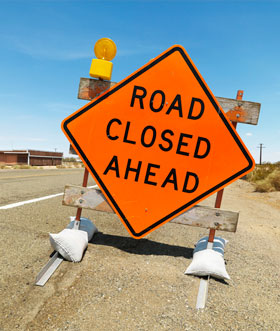 Do you have a contingency plan in place at your company? Contingency planning is vital to survival. Without one, your business could experience major setbacks in the event of a situation that negatively impacts your company’s normal operations.
Do you have a contingency plan in place at your company? Contingency planning is vital to survival. Without one, your business could experience major setbacks in the event of a situation that negatively impacts your company’s normal operations.
While some events are completely unexpected such as natural disasters, accidents on site, and personnel-related risks, other occurrences such as road closures, seasonal slowdowns, and regulatory changes are identified ahead of time and can be mitigated before disrupting your company’s success. The impact of a road closure, for example, could mean loss of car and foot traffic, difficulty maintaining outgoing and incoming shipments, and availability of parking for customers and staff. For this article, a road closure is used for illustration.
What Steps Can I Take in My Community?
Road closures for major upgrades, repairs, etc. are almost always published by the municipality that maintains the roads and streets well before they occur. Short of packing up and moving out or shutting down business for the duration of neighborhood construction, some thoughtful planning may help reduce the disruption to your normal operating procedures.
Step 1: Keep Current on Upcoming Plans in the Community
Stay up to date on upcoming plans in your community by attending council, area road masters, and police meetings. By doing so, you will know when, where, and how long the disruption will affect your business. This will allow you time to plan ahead accordingly. Having local business representation at these meetings could help to soften the impact.
Step 2: Plan a Campaign with Your Fellow Small Business Owners
 After determining the dates, times, and duration of scheduled road closures in your community, schedule a campaign with fellow small business owners so that everyone can work together to brainstorm special sales, create signage, and plan events. This extra planning will help to keep business thriving as much as possible during major disruptions to the regular flow of business.
After determining the dates, times, and duration of scheduled road closures in your community, schedule a campaign with fellow small business owners so that everyone can work together to brainstorm special sales, create signage, and plan events. This extra planning will help to keep business thriving as much as possible during major disruptions to the regular flow of business.
Step 3: Figure out which employees, customers, and suppliers may be affected and devise plans to accommodate them.
This is key when outlining a contingency plan. There is no such thing as a “one size fits all” plan of action. Employees, customers, and suppliers will likely be affected in different ways as a result of disruptions in your community. It is best to devise separate plans for each group and determine how you will be able to best accommodate them when a disruption occurs.
Step 4: Starting a contingency fund to salt away cash as a reserve against the financial impact.
A contingency fund will help your business stay afloat during a shortage of income or an emergency. First, determine how much you need to save. One to three months of operational expenses should be the absolute minimum. Keep in mind any debt repayments your business may have and be sure to factor those in. Next, decide what constitutes an emergency. In other words, decide what instances would be ok for you to tap into your contingency fund. Finally, allot a fraction of revenue to put in savings each month. You may want to speak to your credit union or bank to ensure the account yields good interest.
Other Contingency Planning Tidbits to Keep in Mind
- Contingency planning should start with the annual budgeting process
- Communicate the plan to all employees so everyone is on the same page
- Maintain the plan – revisit your contingency plan regularly, since changes are always occurring



